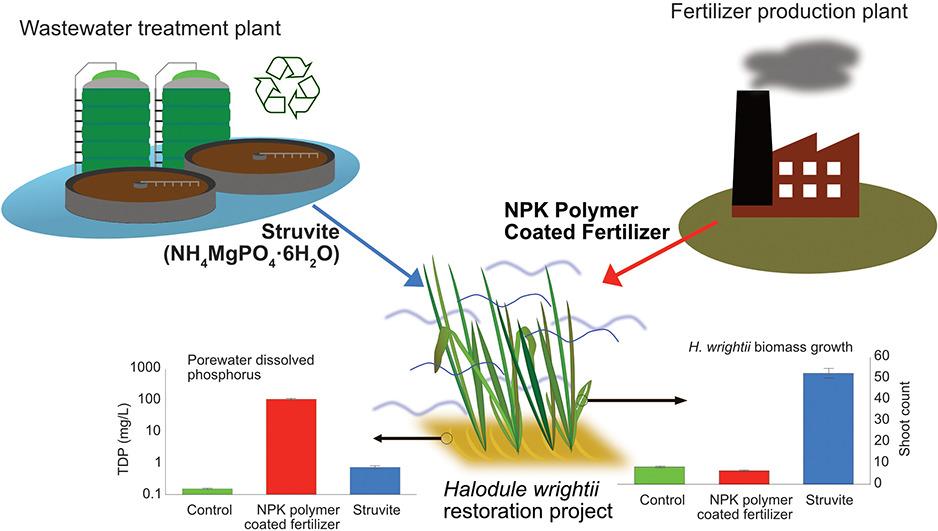New research from the UF/IFAS Department of Soil, Water, and Ecosystem Sciences may improve seagrass restoration efforts. The loss of seagrass is devastating coastal ecosystems. Impacts include declining water quality and marine life dying off or migrating to other areas. To make matters worse, the restoration of seagrasses is both relatively expensive and unsuccessful compared to other coastal ecosystems. struvite
Conor MacDonnell (Ph.D. 2021) worked with Franciszek Bydalek (University of Bath) to study the applications of struvite as a fertilizer for seagrass restoration. You can harvest the crystal compound from wastewater treatment plants. It contains phosphorus and nitrogen – two key ingredients in fertilizer.
“Struvite occurs during the wastewater treatment process because magnesium, ammonia, and phosphate are all readily available to form the crystal byproduct,” MacDonnell explained. “The result is a relatively insoluble, sustainable compound found in wastewater treatment plants.”
That relative insolubility is what led MacDonnell and his dissertation advisor, Dr. Patrick Inglett, and committee member, Dr. Todd Osborne, to investigate whether it could be used to fertilize seagrass.
“While using struvite in aquatic systems appears very promising, there aren’t many studies of it in marine restoration projects, especially in combination with other restoration techniques,” MacDonnell said.
Research Study & Results
The study compared fertilization with struvite and the commonly used controlled-release fertilizer OsmocoteTM as well as a control plot with no added fertilizer. One experiment used 0.5 mg of phosphorus per gram of dry weight, and another used smaller amounts (0.01 mg and 0.025 mg). The seagrass came from St. Martins Marsh Aquatic Preserve in Florida and they planted it in a simulated setting, at the Whitney Laboratory of Marine Biosciences.
“From the two experiments, we found struvite performed better than OsmocoteTM in seagrass growth,” MacDonnell said. “While OsmocoteTM is a controlled release fertilizer, struvite seems to provide a slower, more consistent release of nutrients to the seagrass.” Struvite resulted in increased seagrass growth and higher seedling survival than OsmocoteTM Even better, this happened while Struvite produced lower amounts of porewater nitrogen and phosphorus.

Additionally, a year after the experiment, the OsmocoteTM fertilizer was completely dissolved. The struvite granules were still in the plots, indicating continued release of nutrients and potential for struvite to be effective throughout a whole growing season or longer.
It needs more research, but MacDonnell and his advisor believe there are several advantages for seagrass restoration projects.
“Struvite is potentially less harmful to the environment than traditional fertilizers,” Inglett said. “It is removed from wastewater, so it lessens the impact on downstream ecosystems.”
“Also, it is sustainable, while mining phosphorus is depleting that natural resource at an accelerating rate and degrading the land,” MacDonnell added.
The research is published in the journal Science of The Total Environment. You can read it here.
 1
1
